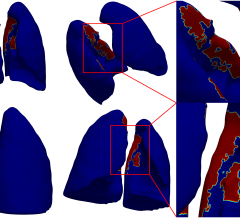
October 31, 2012 — Breast cancer patients who receive radiation treatment do not have a higher risk of long-term cardiac morbidity when compared to patients undergoing modified radical mastectomy (MRM), according to research presented at the American Society for Radiation Oncology’s (ASTRO’s) 54th Annual Meeting. This is the first study to document comprehensive, late cardiac outcomes 25 years after breast cancer treatment.
The study reviewed 247 stage I-II breast cancer patients who were enrolled in the National Cancer Institute (NCI) Breast Conservation Trial from 1979 to 1987 and found that 102 were alive 25.7 years after treatment. Fifty of those patients participated in this study, 26 of whom underwent breast conservation therapy (BCT) using radiation and 24 of whom underwent MRM. Patients were evaluated based on a detailed cardiac history, exam, cardiac labs and 3T cardiac magnetic resonance imaging (CMR) to assess anatomic and functional abnormalities, as well as a computed tomography (CT) angiogram to evaluate for stenotic coronary disease and determine if there was a high coronary arterial calcium score (CAC) for atherosclerosis. Imaging was assessed by a single experienced cardiologist blinded to each randomization arm.
Patient characteristics, exam findings and lab results were statistically similar for patients treated with MRM alone and those treated with BCT using radiation therapy, although BCT patients had somewhat lower rates of diabetes at 3.8 percent versus 12.5 percent for MRM patients. Systolic blood pressure rates were 127 mm Hg versus 139 mm Hg for BCT and MRM patients, respectively. Radiation treatment on patients’ right versus left breast showed no difference in the relevance, severity or distribution of atherosclerosis for BCT patients, including the left anterior descending coronary artery, which is in close proximity to the chest wall and received the highest radiation dose.
Using the Framingham model to assess a patient’s potential risk of developing myocardial infarction (MI) within 10 years of diagnosis and treatment, the study found similar rates between groups — the risk was 5.1 percent for BCT patients and 5.7 percent for MRM patients. Two MRM patients had a prior MI and one had heart failure. Diastolic function, including peak filling rate and diastolic volume recovery, was similar for both patient groups. Other similarities in the CMR findings included peak mid-wall strain and chamber mass, volume and function. The median coronary arterial calcium score (CAC) was similar in both groups at 25 for BCT patients and zero for MRM patients, which are both in the normal range. No patients exhibited myocardial fibrosis, and one patient in each group experienced pericardial thickening. Among BCT patients, cardiac structure and function were similar for right- or left-breast tumors. BCT patients underwent radiation doses of 45 to 48.6 Gy to the whole breast, with a 15 to 20 Gy boost to the tumor bed. The study authors did find that visible atherosclerosis occurred somewhat more often among those receiving chemotherapy for both MRM and BCT patients.
“Over the past two decades, radiation therapy has become more precise and safer with modern techniques,” said Charles B. Simone II, M.D., lead author of the study and a radiation oncologist at the Hospital of the University of Pennsylvania in Philadelphia. “We are pleased to find that early stage breast cancer patients treated with modern radiation therapy treatment planning techniques do not have an increased risk of long-term cardiac toxicity and that breast conservation therapy with radiation should remain a standard treatment option.”
The abstract, “Cardiac Toxicity is Not Increased 25 Years After Treatment of Early-stage Breast Carcinoma with Mastectomy or Breast Conservation Therapy from the National Cancer Institute Randomized Trial,” was presented in detail during a scientific session at ASTRO’s 54th Annual Meeting on Monday, Oct. 29, 2012.
For more information: www.astro.org


 August 29, 2025
August 29, 2025 









